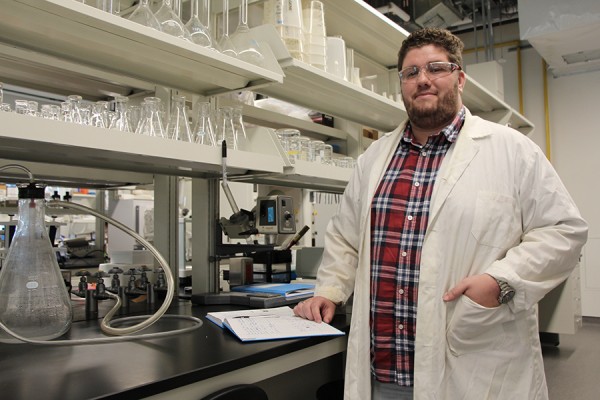 Graduate student Brett Rickeard is travelling to the National Institute of Standards and Technology Centre for Neutron Research in Maryland in August to use the facility’s neutron spin echo spectrometer for his cell research.
Graduate student Brett Rickeard is travelling to the National Institute of Standards and Technology Centre for Neutron Research in Maryland in August to use the facility’s neutron spin echo spectrometer for his cell research.
Scientists around the world compete for the coveted opportunity to use the neutron spin echo spectrometer at NIST, the National Institute of Standards and Technology Centre for Neutron Research in the United States.
For UWindsor’s Brett Rickeard, getting to perform experiments using the instrument is becoming an annual occurrence.
The graduate student in professor Drew Marquardt’s interdisciplinary biochemistry lab will be heading to the NIST facility in Maryland on Aug. 19. He was there in August 2018 as well.
“This is not something most students get to experience,” said Rickeard. “To get to use this extremely high-tech instrument twice is amazing.”
Rickeard, together with undergraduate student Stuart Castillo, will be using neutrons to study the mechanical properties of model mitochondrial membranes. Rickeard has been working on the models for the past several months.
They will introduce an anti-cancer drug to the membranes to determine if the drug makes them more rigid or softer, changes which could have detrimental impacts on cellular processes.
Rickeard said the experiments may help cancer researchers better understand how drug therapies work.
“For the cancer drug we are working with, previous research has shown that it effectively induces cell death. However, the nature of the interaction between the anti-cancer agent and the mitochondria is a mystery. We want to look at the interaction at the atomic level and find out how it works,” he said.
“This will help us better understand the biophysical interaction and the biological consequence.”
Dr. Marquardt said the research melds physics and biology.
“These types are studies are unique in that they use experimental strategies deeply rooted in physics, exploiting the quantum properties of a neutron, to shed light on relevant biological questions and processes.”
The neutron spin echo spectrometer at NIST is one of only eight in the world. Two-thirds of the beam time is set aside for guest researchers who must submit proposals to be allowed to use the instrument. NIST would need seven of the instruments to accommodate all the proposals it receives, making the opportunity to use the instrument rare.
Researchers must undergo training before being allowed to use the spectrometer. Rickeard received the training on his last visit to the Maryland facility, so this year, he’ll be able to use all his time working with the instrument for his research experiment.
He has been granted access to the machine for one week.
“I’ll be there day and night,” he said.
Rickeard, 23, grew up in Essex and completed his undergraduate degree at the University of Windsor. He said, in addition to furthering his research, gaining access to NIST will help advance his career.
“I’m making connections at an esteemed facility. It’s a world-class facility, making me even more excited for the upcoming experiment.”
─ Sarah Sacheli
